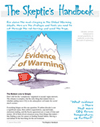|
|
Fig 3 (Part VI only) Sunspot drawing of by G.D. Cassini in 1671 (Oldenburg, 1671c).
What is surprising is just how much data we have on the Sun from 400 years ago.
For some aspects of solar activity we barely have a half a solar cycle. For example, on solar spectral changes: UV and Infrared light swing up and down through the solar cycle, but we only got a good grip on these important changes in the last ten years with the SORCE mission.
But on other aspects of solar activity there is much more long term data than I expected: 400 years ago quite a few people were carefully recording detailed drawings of sun spots (like Cassini in 1671, right). Others were reporting aurorae — up to 150 a year in parish records, newspaper reports, and scientific observations, which tells us something about the strength of the solar wind. There were also observations of the solar corona during eclipses at the time, which suggest the sun was less active as well.
Lately some (Zolotova et al) have said solar activity was not low during the cold Maunder Minimum period from 1645 – 1715. Usoskin and others have responded […]
1954 Yearbook Brisbane
Here’s an update to the digging through our historic records we discussed a month ago, we can now include nearly twice the stations and the difference between temperatures originally recorded 100 years ago and temperatures today are even smaller.
Chris Gillham has been working with CSIR documents and official Commonwealth Year Books. Last month he used the 1953 Year Book which contained 44 weather station averages for 1911-40 to compare with 2000-14 temperatures, but has since discovered that the 1954 Year Book provides an additional 40 stations with 1911-40 data. The average rise in mean temperatures across all 84 weather stations around Australia over the last 70 years of global warming is about 0.3C. This larger dataset suggests as much as two thirds of the current official trend in Australian warming was due to post hoc adjustments, not heat recorded by thermometers.
These historic temperatures were calculated by the best scientists of the day, using the best equipment of the era (the same Stevenson Screen we use now). Yet again, global warming appears to have a “man-made” contribution. Far more important than CO2 is man-made “pollution” called homogenisation.
When doubling the recorded trend makes “No difference”
[…]
Yet more evidence that there is no relationship between CO2 and cyclones, hurricanes, and typhoons. This paper from 2012 tests the theory that global warming made storms more severe and tried to find any effect on typhoons hitting Japan that could be linked to climate change since 1980.
There has been no increase in “super typhoons”. The typhoon season is not longer, nor is it delayed in starting. There has been no change in intensity. The wind speeds are not increasing. The minimum pressure is pretty much the same.
CO2 appears to influence storms in simulated worlds, but not so much in the real one. There is no sign of more severe storms in Australia, New Zealand or the South Pacific either. Nor is there any pattern in the Global Energy indicies, US Hurricanes, US Tornadoes either.
When will scientists and reporters make sure that their audiences know that?
The authors conclude:
“The results suggest that typhoons have not been influenced by global warming. In conclusion, global warming has not significantly changed the characteristics of typhoons, and there is no close relationship between the two.”
Figure 19. Number of super typhoons that develop
9.4 […]
When it comes to our rare high-quality historic records, and the real long term trends of Australian weather, the silence is striking. There are some excellent historical records of long term temperature data from the late 1800s in Australia, which lie underused and largely ignored by the BOM.
For the BOM, history almost appears to start in 1910, yet the modern type of Stevenson screen thermometer was installed across Australia starting as early as 1884 in Adelaide. Most stations in Queensland were converted as long ago as 1889 and in South Australia by 1892. Though states like NSW and Victoria were delayed until 1908.
Here’s a photo of the ones in Brisbane in 1890.
Brisbane was recording temperatures with modern Stevenson screens in 1890, as were some other stations, but the BOM often ignores these long records.
The BOM don’t often mention all their older temperature data. They argue that all the recordings then were not taken with standardized equipment. The BOM prefers to start long term graphs and trends from 1910 (except when they start in 1950 or 1970, or 1993).
The BOM was set up in 1908. Before that there were Stevenson screens going in […]
Skeptics, and particularly Nils-Axel Mörner have been saying that sea level rise, as recorded by tide gauges has been much slower than widely advertised. They’ve also pointed out how the rates of sea-level rise have either stayed the same or slowed down. There’s been no sign of the acceleration needed for the wildly speculative hypothesis that your SUV, and China’s coal plants are warming the ocean.
This week a new Nature paper (Hay et al) shows the skeptics were right — but did that view make it to any news broadcast?
Watch the sea-level scare mutate
Even in The Australian the spin from the propaganda machine gets a running, and the previous slow rise is used to pump the scare that the modern “acceleration” is even scarier. What the Australian (and selected sea level “experts”) don’t mention is that the tide-gauges don’t show any acceleration, and nor did the raw recordings from satellites. The 3mm rising sea claims apparently come from satellites that were calibrated to one subsiding tide gauge in Hong Kong.
It’s cherry picking par excellence. We might finally accept tide gauges up to 1990, but after that the tide gauges don’t count — bring in the “adjusted” […]
A new study of Law Dome Ice cores tells us that droughts are common in Australia, and that there appears to be eight mega-droughts over the last thousand years, including one that lasted a whopping 39 years from 1174- 1212AD. By their reckoning the 12th Century in Australia was a shocker with 80% of it spent in drought conditions. Things weren’t so bad from 1260 – 1860, at least, as far as they can tell. The researchers are convinced theirs is the first millennial-length Australian drought record. It does seem significant.
The researchers, sensibly, think we might want to pay attention to the Pacific cycles and store a bit more water. Without fanfare the paper also suggests that droughts were worse in medieval times.
“this work suggests Australia may also have experienced mega-droughts during the Medieval period that have no modern analog. Therefore, management of water infrastructure in eastern Australia needs to account for decadal-scale droughts being a normal feature of the hydrological cycle.”
h/t to Paul Homewood at Notalotofpeopleknowthat
The ABC reported this largely as a water management story, without asking whether their past stories that blamed CO2 for droughts were less likely to be true. […]
As I’ve repeatedly posted this year, there is a strange coincidence between geothermal activity and warming in Antarctica. We are still discovering volcanoes underwater, so we can’t pretend we have accurate data on their contribution in joules or the trends in that. On Antarctica almost all the headlines of doom and collapse come from West Antarctic peninsula or the ice sheet nearby which also happen to be over the West Antarctic Rift System. Most other places in and around Antarctica are cooling or staying the same, and sea ice is hitting record levels. “Must be CO2 then.” ; -)
Damiani et al looked at the crustal thickness beneath Thwaites Glacier, and finds it is quite thin, like that beneath the Pine Island Glacier. The researchers conclude that it is likely there is a major volcanic dome in Marie Byrd Land.[1]
Spot any media mention of the possibility that hot lava might be to blame instead of your SUV.[2] Good little propaganda writers produce plenty of gloom and doom headlines of the imminent collapse of ice-sheets. Where are the journalists? For that matter — which climate scientist tries to make sure journalists present an accurate report?
h/t The HockeySchtick
..
[…]
Two papers on ocean heat released together today. The first says the missing heat is not in the deep ocean abyss below 2000m. The second finds the missing heat in missing data in the Southern Hemisphere instead. Toss out one excuse, move to another.
The first paper by Llovel and Willis et al, looked at the total sea-level rise as measured by adjusted satellites*, then removed the part of that rise due to expanding warming oceans above 2,000 m and the part due to ice melting off glaciers and ice-sheets.** The upshot is that the bottom half of the ocean is apparently not warming — there was nothing much left for the deep oceans to do. This result comes from Argo buoy data which went into full operation in 2005. (Before Argo the uncertainties in ocean temperature measurements massively outweigh the expected temperature changes, so the “data” is pretty useless.)
Figure 2 | Global mean steric sea-level change contributions from different layers of the ocean. 0–2,000m (red), 0–700m (green), 700–2,000m (blue). The dashed black curve shows an estimate for the remainder of the ocean below 2,000m computed by removing the 0–2,000m estimate from the GRACE-corrected observed mean sea-level time […]
This new paper by Adophi et al uses beryllium, oxygen and carbon isotopes from Greenland ice cores right back as far as the depth of the last ice age, 22,500 years ago, and finds there is a link between solar activity and the climate. It follows these proxies of temperature and solar activity as the planet warmed to the start of the Holocene 10,000 years ago.
It is gaining attention in The Daily Mail, with the headline:
Is the SUN driving climate change? Solar activity – ‘and not just humans’ – could be increasing global warming, study claims
During the last glacial maximum, Sweden was covered in a thick ice sheet that stretched all the way down to northern Germany and sea levels were more than 330ft (100m) lower than they are today, because the water was frozen in the extensive ice caps.
‘The study shows an unexpected link between solar activity and climate change,’ Dr Muscheler said in a press release.
‘It shows both that changes in solar activity are nothing new and that solar activity influences the climate, especially on a regional level.
Dr Joanna Haigh, […]
Who would have thought? Antarctic volcanoes are hot after all. Having a volcano under an icesheet makes a difference, and some of the sea level rise blamed on CO2 is more likely to be because 1,000 °C lava is not far from sub-zero ice. Right now, according to scientist Dustin Schroeder and co, it is as if the Thwaites Glacier in West Antarctic is sitting on a “stovetop burner”.[1]
Only last week I wondered if West Antarctic volcanoes had something to do with the Antarctic warming and pointed out this strange coincidence below where almost all the warming seems to occur over the volcanic area which is part of the hot “Pacific rim of fire”. I also wondered why some parts of the media don’t seem to mention the volcanoes. Wait and see if this story gets picked up. So far, Fox, and Business Insider have it.
“Using radar data from satellites in orbit, the researchers were able to figure out where these subglacial streams were too full to be explained by flow from upstream. The swollen streams revealed spots of unusually high melt, Schroeder said. Next, the researchers checked out the subglacial geology in the region and found that […]
A new study by Steinke shows that the sun could have been a driver (somehow) of some of the monsoonal rain changes over the last 6,000 years over Indonesia and Northern Australia. h/t to The Hockey Schtick
In the spirit of the Perfect ClimateTM that existed prior to Henry Ford, we also find that Indonesia had a dry spell that lasted for a while, like say, 3,000 years. It ended about 800BC whereupon things got wetter, and mostly stayed wetter. The authors (Steinke et al) think this might have something to do with solar minima which was very low 2800 years ago. (Though I note the Greek Dark Ages also finished then, and “city states” arose, right, so it could have been that too. Ahem?)
To get straight to the action in Figure 6 the top squiggly line is AISM Rainfall (that’s the Australian-Indonesian summer monsoon). It shows how things were wetter in the last 2800 years ago and drier before that (annoyingly, the present time is on the left). The second part of the graph in red shows sunspot numbers. That gets flipped upside down and superimposed on the rainfall graph in the third part, and we can see […]
Could this be why climate models do rainfall with all the competence of tea-leaf-reading? Tiwari et al report that as much as 47% of the recharge rates of ground water in China are controlled by the sun. Apparently climate models miss the minor factor of the major cycles.
Try this radical idea on: imagine a world where climate models worked. Not only could the BoM warn people that there would be a drought coming, they could name the region, and the years.
Tiwari et al:
Here for the purpose of comparison of long term ground water recharge rates with long term solar activity, we used the 10-year average sunspot time series, for the period 1300 to 1905 AD, published by Solanki et al., [2004]. Also the additional average annual sunspot number time series (1700 to 2000 AD) is used from data source Solar Influences Data Analysis Centre. In addition to decadal data annual sunspot number data from 1700 to 2000 AD downloaded from Solar Influences Data Analysis Centre is used in the present study. The cross-correlation coefficient (+0.63) between the groundwater recharge rate time series and decadal sunspot number [Solanki et al., 2004] shows that there is statistically significant solar […]
UPDATE: Cyclone Ita is now Category 5 bearing down on Cooktown in North Queensland, the radars will show it soon. 175km NNE of Cooktown. Winds up to 300km /hr. 931 hPa. See The BOM warnings. Thoughts for those in the path. (It’s clearly visible in the satellite image on the radar link).
——————————————————————————–
A new paper by Andrew Dowdy tells us that from 1980 to 2013 the incidence of tropical cyclones around Australia has been falling. If CO2 is influencing cyclones around Australia, presumably this implies we should burn more coal.
Those convinced about the power of CO2 will point out that the models predict an increase in intensity, not frequency. To that end, I say: see the BOM graph below. Note the red bars marked “severe”. Then tell yourself that the science is settled and we should spend billions to change those trends. The BOM say “the number of severe tropical cyclones (minimum central pressure less than 970 hPa) shows no clear trend over the past 40 years.”
Interestingly Callaghan et al 2010 goes back all the way to 1870. It finds the trend of severe land-falling cyclones has fallen by a whopping […]
I decided that the IPCC Impacts report was irrelevant speculation because it utterly depended on the IPCC science report and the climate models which we already know are wrong. But the dedicated team at NIPCC show that, even if we take the claims of “impacts” working group seriously, they still come to nothing. Atmospheric CO2 is not a pollutant, there is little risk of famine due to our emissions or due to global warming. Life in the oceans is likely to adapt reasonably well as so many studies have shown, and less humans will die overall as a bonus. For those of you who enjoy well written, well researched arguments, and especially if you are looking for scientific references and the nuance of this debate, there is much to learn. The NIPCC reports are an invaluable reference for me. Careful scientific language is so much more informative than the full-gloss IPCC double-speak about theories which are consistent with uncertainties but not with observations – Jo
————————————————————
Report Finds Global Warming Causes ‘No Net Harm’ to Environment or Human Health Independent review of climate science contradicts “alarmist” views of United Nations […]
A new paper (Moffa-Sánchez et al) reports that they looked at layers of dead plankton in ocean mud (otherwise known as foraminifera in marine sediments) and have reconstructed the temperature and salinity of a couple of spots in the North Atlantic between 818AD – 1780 with data on δ18O and the Mg/Ca ratios. One immediate thought, an aside, is that if this technique works, there is no shortage of ocean mud, surely, and perhaps we could drill and analyze more mud for solar correlations in other places. (I hear foraminifera live in the Southern Hemisphere too). Perhaps no one is looking for the connection with the sun?
Moffa-Sánchez et al find the big climate shifts (the 100-year variations) correlate with total solar irradiance (TSI). See especially that orange line black line track in the d graph below. I stress, correlations don’t mean causation and the mechanism is mere speculation. But I find the graph intruiging. There are a lot of turning points, and in pure “curve fitting” type of analysis, this is a better curve fit than the one with CO2. (Find me a turning point that matches with carbon dioxide!) I suspect we’ll be referring back to this paper, […]
A new paper shows that sea levels rose faster in the ten years from 1993-2003 than they have since. Sea levels are still rising but the rate has slowed since 2004. This does not suggest that the missing energy from the atmosphere has snuck into the ocean, but rather that the oceans and the atmosphere were both warming faster in the 1990’s, then as coal power ramped up in China and billions of tons of CO2 was released, both the atmosphere and the ocean did not gain more energy per year, but less. That message again — something else appears to be the main driver the climate, not CO2.
Their highlights include:
The global mean sea level started decelerated rising since 2004. Deceleration is due to slowdown of ocean thermal expansion during last decade. Recent ENSO events introduce large uncertainty of long-term trend estimation.
This paper discusses and graphs total sea level rise, steric sea level rise and the global mean ocean mass. The Steric Sea Level is the part of the rise due to warming and salinity changes, so it best represents changes in ocean heat content. The total rise also includes water coming or going due to changes […]
Rosenthal et al have put out quite a humdinger of a paper. They’ve reconstructed the temperature of the water flowing out of the Pacific to the Indian Ocean over the last 10,000 years and as deep as 900m. The Indonesian Throughflow is pretty significant in global ocean currents. There’s narrow routes for Pacific upper waters to squeeze through to the Indian Ocean through the Makassar and Lombok Straits, and via the Lifamatola Passage through the Banda Sea, and water comes in from both the North and South Pacific.
An important point in global ocean currents where the Pacific flows through to the Indian Ocean.
Points to note (assuming the study is right):
Temperatures started rising around 1700AD — long before our carbon emissions. That temperatures were much warmer (0.65C) in 1100AD than they were in 1950. 8,000 years ago water was 1.5 to 2 degrees warmer — isn’t that meant to be a global catastrophe? Apparently coral reefs, fish, and turtles survived.
Figure 4. Holocene changes in Pacific Ocean heat content. (A) Reconstructed anomalies in Pacific OHC in the 0- to 700-m depth interval for the early Holocene, mid-Holocene, MWP, and LIA periods. Reconstructed anomalies are calculated […]
A team of researchers looked at the solar influence on Southern Hemisphere Westerly Winds (SWW). These winds influence rainfall patterns and ocean currents in the Southern Hemisphere. Varma et al infer rainfall patterns by looking at iron deposits in marine sediments near Chile, which are apparently higher during drier conditions and lower during wetter times. They compared these to both Beryllium (10Be) and Carbon-14 (14C) which they use to estimate solar activity.
The end result is they find that the westerly winds shift northwards towards the equator during lower solar activity, and conversely move southwards towards the poles during higher solar activity. The shifting wind patterns move the rainfall. An effect is apparent in records for the last 3,000 years.
In graph a below, 10Be (solar activity) and Fe (rainfall) have a decent correlation coefficient (r) of 0.45, while the 14C (solar activity) and Fe (rainfall) correlation in b has a lower correlation (r) of 0.21. Varma et al say:
“the large correlation coefficient for 10Be would suggest that ca. 20% (i.e., r2) of late Holocene rainfall and hence SWW variability could be attributable to solar forcing.”
They conclude that the current models don’t give the sun a […]
“…the role of the Sun is one of the largest unknowns in the climate system”
Meteorologists are already aware that changes in the interplanetary magnetic field (IMF) can affect the polar regions of Earth. Now, for the first time Lam et al report the magnetic field appears to influence atmospheric pressure in the mid latitudes. Lam compared the average surface pressure at times when the magnetic field is either very strong or very weak and found a statistically significant wave structure similar to an atmospheric Rossby wave. They claim to show that this works through a mechanism that is a conventional meteorological process, and that the effect is large enough to influence weather patterns in the mid-latitudes. The size of the effect is similar to “initial analysis uncertainties” in “ensemble numerical weather prediction” (which I take to mean “climate models”).
They are suggesting that small changes in this solar influence on the upper atmosphere could produce important changes through “non-linear evolution of atmospheric dynamics”.
Jo suggests that IPCC-favoured climate models don’t include any solar magnetic effect at all, which is just one of many reasons why they don’t work.
The large scale wandering convolutions of the jet […]
A paper that is nearly 60 years old shows us just how intrinsically important CO2 is to life.
An acre of corn is a living machine drawing CO2 from the air around it. In windless conditions, CO2 concentrations over a cornfield build up each night as CO2 diffuses from higher air and the organic matter and bacteria create CO2 from the soil. A paper by Chapman et al from 1954[1], shows that as soon as the sun comes up, to power-up those dormant photosynthetic cells, the plants rapidly draw down as much CO2 as possible, and when the CO2 levels fall too low, plant growth surely slows.
On a windless day CO2 values rose to 410ppm overnight and fell to 210ppm during the morning.
This graph shows CO2 content of the air over a cornfield on a still day (no wind). Sunrise occurs at 5am and CO2 levels plummet til 8am, reaching their lowest by 1pm, which is nearly half the CO2 concentration of the peak reached overnight. The corn is affecting CO2 levels in air even as high as 150m or 500ft above. These level out by around 8am and only start to increase again, a couple of hours […]
|
JoNova A science presenter, writer, speaker & former TV host; author of The Skeptic's Handbook (over 200,000 copies distributed & available in 15 languages).

Jo appreciates your support to help her keep doing what she does. This blog is funded by donations. Thanks!


 Follow Jo's Tweets
Follow Jo's Tweets To report "lost" comments or defamatory and offensive remarks, email the moderators at: support.jonova AT proton.me
Statistics
The nerds have the numbers on precious metals investments on the ASX
|












Recent Comments